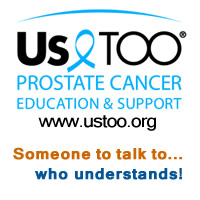|
||||||||
| Home | News You Can Use |
About Us TOO Florence |
Personal Journeys | Slideshows | Contact Us | |||
| Each man's Journey is listed under his BASIC treatment. When you click on one of the names to read a particular Journey, you may see one or more different treatments in bold lettering immediately above the Journey text. You will see (Recurrence) if they are due to a recurrence. Otherwise, they will be treatments used in conjunction with the basic treatment, i.e. Lupron with External Beam Radiation or External Beam Radiation with HDRT/Brachytherapy, etc. | |
Active Surveillance Alternative (Natural) Therapy Cryoablation - Freezing Hormone Therapy Radiation - Brachytherapy Radiation - External Beam Radiation - HDRT Surgery - Open Surgery - Robotic |
I had been experiencing urinary urgency for several years and had discussed it with my primary care physician, ultimately deciding to give Avodart a try. When checked in 2007, my PSA was a reasonable 3.3. I had received a DRE (digital rectal exam) by three different doctors over the last several years with no abnormality being detected. With all of that, BPH (benign prostatic hyperplasia) seemed an appropriate diagnosis. Before I could get my BPH resolved, I underwent back surgery in 2008. When the catheter was removed prior to my discharge from the hospital, the nurses noticed a urine retention problem. They did an ultra-sound which showed that I had 500cc of urine still in my bladder. They told me, "Either you get rid of that or the catheter goes back in." All I could do was reduce the retention to 200-300 cc. With that being my best effort, the nurses told me to see a urologist. So, it was off to see Dr. Leo Kusuda at the North Bend Medical Center. Following my DRE examination, Dr. Kusuda immediately said, "I don't like that," and scheduled the prostate biopsy. He also ordered a PSA test which was 2.9, a good number. Having a good PSA, but a questionable DRE threw me into the 20-25 % of men whose PSA doesn't rise with prostate cancer. Not knowing who is in that 20-25 % is why men must have both the DRE exam as well as the PSA blood test. On May 19, 2008, I officially became a prostate cancer survivor. The results of the biopsy showed I did have prostate cancer with my Gleason Scores being one (7) and five (6s). With a Gleason Score of 10 being totally aggressive, my cancer was mildly to moderately aggressive. Dr. Kusuda sent the results to Seattle Prostate Institute for a second opinion and they in turn forwarded them on to Johns Hopkins for further review. Johns Hopkins revised the results somewhat by changing one 6 to a 7. That was not a drastic change, but it did mean that my cancer was more aggressive than previously thought. Getting those extra reviews of my Gleason Scores was invaluable. These scores are obtained by a pathologist examining the cancer cells through a microscope and scoring them solely by their appearance. It is critical to have a pathologist who is experienced in scoring prostate cancer cells. The Gleason Scores need to be accurate because they are a significant part of the information upon which treatment (or no treatment) is based. Decision time! A couple local men in Bandon discussed with me the treatment they chose, but that still left me with many unanswered questions. I considered Proton Beam in Loma Linda, Calif., but the wait there was at least six months. I finally came to the conclusion that I wanted to keep my body parts because I had heard so many bad things about prostate surgery such as no erection and uncontrollable bladder that I didn't want to go there. Having made that decision, I told Dr. Kusuda that I wanted to go to the very best place for treatment and didn't want to take the chance of any problem. Dr. Kusuda suggested the Seattle Prostate Institute for brachytherapy (seed implant) and I saw Dr. Peter Grimm on June 2, 2008. On July 1, 2008, I was admitted to the Swedish Medical Center in Seattle and radioactive seeds were implanted that day. I returned the next day for my post-op check up, got an ok and my wife, Lori, drove me home to Bandon. On August 26, 2008, I started 25 sessions of external beam radiation with Dr. Jenson at the Bay Area Hospital in Coos Bay to take care of any cancer cells that might have escaped my prostate. Five months following the seed implant and a month after finishing my external beam radiation, my PSA had dropped to 0.6. The second reading in June 2009 was 0.2. I am very pleased with those numbers and am doing well. I started attending Florence Man to Man in June 2009, wanting to give my support to other prostate cancer survivors. What I found was a warm, understanding and informed group of men and women who welcomed me as family. Had I known of this group before I made my treatment decision, I certainly would have attended and made use of the personal experiences these men so willingly share. Having Dr. Mehlhaff at these meetings to answer medical questions is an unbelievable bonus. This is one group I highly recommend! |
| www.ustooflorence.org Copyright © 2010 - 2024 | |

